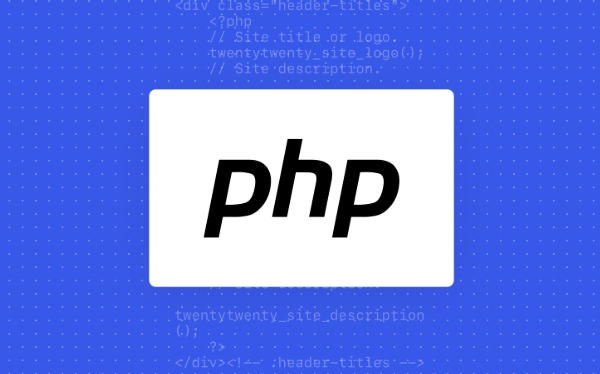 Backend Development
Backend Development
 PHP Tutorial
PHP Tutorial
 Mastering Loop Control: A Deep Dive into the PHP `break` Statement
Mastering Loop Control: A Deep Dive into the PHP `break` Statement
Mastering Loop Control: A Deep Dive into the PHP `break` Statement
Aug 02, 2025 am 09:28 AMThe break statement in PHP exits the innermost loop or switch, and can optionally exit multiple nested levels using a numeric argument; 1. break stops the current loop or switch, 2. break with a number (e.g., break 2) exits that many enclosing structures, 3. it is useful for efficiency and control in nested loops or switches, 4. best practices include using it to terminate early when a condition is met, avoiding fall-through in switches, and refactoring complex cases into functions, 5. alternatives like early return or flags can improve readability when deep breaks are needed, and overusing break, especially beyond two levels, should be avoided to maintain code clarity and predictability.

The break statement in PHP is deceptively simple — it exits from a loop or switch structure — but mastering its use requires understanding not just how it works, but when and why to use it effectively. While often used in basic loops, break becomes especially powerful in nested structures and multi-level control scenarios. Let’s explore the ins and outs of break to help you write cleaner, more predictable code.

How break Works in Loops and Switches
At its core, break immediately terminates execution of the innermost loop or switch statement. Once encountered, PHP jumps to the first line of code after the loop or switch block.
for ($i = 1; $i <= 10; $i ) {
if ($i === 5) {
break;
}
echo $i . " ";
}
// Output: 1 2 3 4In this example, the loop stops when $i reaches 5. The remaining iterations are skipped entirely.

In a switch statement, break prevents fall-through behavior:
$day = 'Monday';
switch ($day) {
case 'Monday':
echo "Start of the week";
break;
case 'Friday':
echo "Weekend is near";
break;
default:
echo "Regular day";
}Without break, PHP would execute all subsequent cases — a common source of bugs.

Using break with Numeric Arguments in Nested Loops
One of PHP’s unique features is that break can accept an optional numeric argument indicating how many levels of nested structures to exit.
By default, break (or break 1) exits only the current loop. But break 2 exits the current loop and the one wrapping it, and so on.
for ($i = 1; $i <= 3; $i ) {
for ($j = 1; $j <= 3; $j ) {
if ($i == 2 && $j == 2) {
break 2;
}
echo "i=$i, j=$j\n";
}
}Output:
i=1, j=1 i=1, j=2 i=1, j=3 i=2, j=1
The entire nested loop structure stops when i=2 and j=2. This is especially useful when searching through multi-dimensional arrays or processing deeply nested data.
Common use cases for break N:
- Exiting multiple loops after finding a match
- Breaking out of validation routines with nested conditions
- Avoiding flags like
$found = trueto control outer loops
Just be cautious — overusing break 2 or higher can make code harder to follow. Consider restructuring logic with functions if nesting gets too deep.
Best Practices and Common Pitfalls
While break is essential, misuse can lead to hard-to-debug code.
Do:
- Use
breakto improve efficiency (e.g., stop searching once a match is found) - Always include
breakinswitchcases unless fall-through is intentional - Comment complex
breakconditions for clarity
Avoid:
- Overusing
breakin long loops, which can obscure control flow - Using
breakoutside of loops or switches — it will cause a fatal error - Relying on high-level breaks (
break 3) without refactoring into functions
Also, remember that break does not work inside closures or anonymous functions the same way — it applies only to the nearest loop or switch in the current scope.
Alternatives and When to Use Them
Sometimes, break isn’t the cleanest solution. Consider these alternatives:
- Return early: In functions, returning a value early can eliminate the need for breaking.
- Use flags: A boolean like
$done = truecan signal outer loops to exit, improving readability. - Refactor into a function: Extract nested loops into a separate function and use
returninstead ofbreak 2.
Example with early return:
function findValue($matrix, $target) {
foreach ($matrix as $row) {
foreach ($row as $value) {
if ($value === $target) {
return true;
}
}
}
return false;
}This avoids break 2 entirely and makes the intent clearer.
Using break effectively means balancing control and clarity. Know when to stop a loop early, how many levels you're breaking out of, and when to refactor for better design. With thoughtful use, break becomes not just a tool for stopping loops, but a way to write more efficient and readable PHP code.
Basically, master the basics, respect the nesting, and don’t overcomplicate it.
The above is the detailed content of Mastering Loop Control: A Deep Dive into the PHP `break` Statement. For more information, please follow other related articles on the PHP Chinese website!

Hot AI Tools

Undress AI Tool
Undress images for free

Undresser.AI Undress
AI-powered app for creating realistic nude photos

AI Clothes Remover
Online AI tool for removing clothes from photos.

Clothoff.io
AI clothes remover

Video Face Swap
Swap faces in any video effortlessly with our completely free AI face swap tool!

Hot Article

Hot Tools

Notepad++7.3.1
Easy-to-use and free code editor

SublimeText3 Chinese version
Chinese version, very easy to use

Zend Studio 13.0.1
Powerful PHP integrated development environment

Dreamweaver CS6
Visual web development tools

SublimeText3 Mac version
God-level code editing software (SublimeText3)

Hot Topics
 PHP Variable Scope Explained
Jul 17, 2025 am 04:16 AM
PHP Variable Scope Explained
Jul 17, 2025 am 04:16 AM
Common problems and solutions for PHP variable scope include: 1. The global variable cannot be accessed within the function, and it needs to be passed in using the global keyword or parameter; 2. The static variable is declared with static, and it is only initialized once and the value is maintained between multiple calls; 3. Hyperglobal variables such as $_GET and $_POST can be used directly in any scope, but you need to pay attention to safe filtering; 4. Anonymous functions need to introduce parent scope variables through the use keyword, and when modifying external variables, you need to pass a reference. Mastering these rules can help avoid errors and improve code stability.
 How to handle File Uploads securely in PHP?
Jul 08, 2025 am 02:37 AM
How to handle File Uploads securely in PHP?
Jul 08, 2025 am 02:37 AM
To safely handle PHP file uploads, you need to verify the source and type, control the file name and path, set server restrictions, and process media files twice. 1. Verify the upload source to prevent CSRF through token and detect the real MIME type through finfo_file using whitelist control; 2. Rename the file to a random string and determine the extension to store it in a non-Web directory according to the detection type; 3. PHP configuration limits the upload size and temporary directory Nginx/Apache prohibits access to the upload directory; 4. The GD library resaves the pictures to clear potential malicious data.
 Commenting Out Code in PHP
Jul 18, 2025 am 04:57 AM
Commenting Out Code in PHP
Jul 18, 2025 am 04:57 AM
There are three common methods for PHP comment code: 1. Use // or # to block one line of code, and it is recommended to use //; 2. Use /.../ to wrap code blocks with multiple lines, which cannot be nested but can be crossed; 3. Combination skills comments such as using /if(){}/ to control logic blocks, or to improve efficiency with editor shortcut keys, you should pay attention to closing symbols and avoid nesting when using them.
 How Do Generators Work in PHP?
Jul 11, 2025 am 03:12 AM
How Do Generators Work in PHP?
Jul 11, 2025 am 03:12 AM
AgeneratorinPHPisamemory-efficientwaytoiterateoverlargedatasetsbyyieldingvaluesoneatatimeinsteadofreturningthemallatonce.1.Generatorsusetheyieldkeywordtoproducevaluesondemand,reducingmemoryusage.2.Theyareusefulforhandlingbigloops,readinglargefiles,or
 Tips for Writing PHP Comments
Jul 18, 2025 am 04:51 AM
Tips for Writing PHP Comments
Jul 18, 2025 am 04:51 AM
The key to writing PHP comments is to clarify the purpose and specifications. Comments should explain "why" rather than "what was done", avoiding redundancy or too simplicity. 1. Use a unified format, such as docblock (/*/) for class and method descriptions to improve readability and tool compatibility; 2. Emphasize the reasons behind the logic, such as why JS jumps need to be output manually; 3. Add an overview description before complex code, describe the process in steps, and help understand the overall idea; 4. Use TODO and FIXME rationally to mark to-do items and problems to facilitate subsequent tracking and collaboration. Good annotations can reduce communication costs and improve code maintenance efficiency.
 Quick PHP Installation Tutorial
Jul 18, 2025 am 04:52 AM
Quick PHP Installation Tutorial
Jul 18, 2025 am 04:52 AM
ToinstallPHPquickly,useXAMPPonWindowsorHomebrewonmacOS.1.OnWindows,downloadandinstallXAMPP,selectcomponents,startApache,andplacefilesinhtdocs.2.Alternatively,manuallyinstallPHPfromphp.netandsetupaserverlikeApache.3.OnmacOS,installHomebrew,thenrun'bre
 Learning PHP: A Beginner's Guide
Jul 18, 2025 am 04:54 AM
Learning PHP: A Beginner's Guide
Jul 18, 2025 am 04:54 AM
TolearnPHPeffectively,startbysettingupalocalserverenvironmentusingtoolslikeXAMPPandacodeeditorlikeVSCode.1)InstallXAMPPforApache,MySQL,andPHP.2)Useacodeeditorforsyntaxsupport.3)TestyoursetupwithasimplePHPfile.Next,learnPHPbasicsincludingvariables,ech
 How to access a character in a string by index in PHP
Jul 12, 2025 am 03:15 AM
How to access a character in a string by index in PHP
Jul 12, 2025 am 03:15 AM
In PHP, you can use square brackets or curly braces to obtain string specific index characters, but square brackets are recommended; the index starts from 0, and the access outside the range returns a null value and cannot be assigned a value; mb_substr is required to handle multi-byte characters. For example: $str="hello";echo$str[0]; output h; and Chinese characters such as mb_substr($str,1,1) need to obtain the correct result; in actual applications, the length of the string should be checked before looping, dynamic strings need to be verified for validity, and multilingual projects recommend using multi-byte security functions uniformly.





